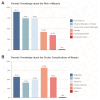Chinese parents' knowledge, attitude, and practice of myopia control: 2023 update
- PMID: 40001101
- PMCID: PMC11863461
- DOI: 10.1186/s12889-025-22003-z
Chinese parents' knowledge, attitude, and practice of myopia control: 2023 update
Abstract
Background: Our previous survey identified a lack of knowledge of myopia among Chinese parents. This research aims to update the characteristics of parents' knowledge, attitude, and practice in myopia control.
Methods: A self-administered questionnaire was disseminated to parents of myopic children in 16 hospitals from 11 provinces in China. Comprehensive information regarding the knowledge, attitude, and practice in myopia of parents with myopic children was collected, with the underlying correlations being analyzed.
Results: A total of 1266 valid questionnaires were collected. The concern over children's visual problems arose significantly earlier among myopic parents (P < 0.001). Axial length was recorded by 29.9% (378/1266) of the participants. Parents' primary goal of myopia control was "retarding the progression of myopia" (64.8%, 821/1266). The effectiveness of behavioral intervention was ranked first by 68.4% (866/1266) of the participants. Single-vision spectacles were the most adopted correction practice (26.1%, 331/1266). In terms of myopic interventions, 23.5% (297/1266) of the parents chose myopic control spectacles, followed by orthokeratology (20.9%, 264/1266); 37.3% (189/507) of the participants believed that the latter was more effective. Most parents (69.8%, 883/1266) expressed satisfaction with the current efficacy of myopia control.
Conclusion: Insufficient awareness of myopia and myopia control was identified among parents of myopic children in China. Efforts should be made to enhance parents' knowledge, raise their awareness, and improve the accessibility and affordability of effective myopia control interventions.
Keywords: Attitude; Knowledge; Myopia control; Practice; Survey.
© 2025. The Author(s).
Conflict of interest statement
Declarations. Ethics approval and consent to participate: This study complied with the Declaration of Helsinki and was authorized by the Ethics Committee of the Fudan University Eye and ENT Hospital (No. 2023026). Consent for publication: Not applicable. Competing interests: The authors declare no competing interests.
Figures




Similar articles
-
A Survey of Myopia Correction Pattern of Children and Parent's Attitudes in China.Optom Vis Sci. 2023 Jun 1;100(6):388-396. doi: 10.1097/OPX.0000000000002028. Epub 2023 May 19. Optom Vis Sci. 2023. PMID: 37200197
-
Knowledge, attitude, and practice among parents of myopic children regarding multifocal soft contact lenses.BMC Public Health. 2025 Jun 10;25(1):2159. doi: 10.1186/s12889-025-23408-6. BMC Public Health. 2025. PMID: 40495120 Free PMC article.
-
The gap between parental knowledge and children practice of myopia control and challenge under COVID-19: a web-based survey in China.Front Public Health. 2024 Jun 12;12:1344188. doi: 10.3389/fpubh.2024.1344188. eCollection 2024. Front Public Health. 2024. PMID: 38932774 Free PMC article.
-
Analysis of parental decisions to use orthokeratology for myopia control in successful wearers.Ophthalmic Physiol Opt. 2021 Jan;41(1):3-12. doi: 10.1111/opo.12744. Epub 2020 Oct 16. Ophthalmic Physiol Opt. 2021. PMID: 33063901 Review.
-
Myopia Control: A Review.Eye Contact Lens. 2016 Jan;42(1):3-8. doi: 10.1097/ICL.0000000000000207. Eye Contact Lens. 2016. PMID: 26513719 Review.
References
-
- Morgan IG, Ohno-Matsui K, Saw SM. Myopia Lancet. 2012;379(9827):1739–48. - PubMed
-
- Daily Ps. The 2018 National Survey on Myopia among Children and Adolescents.: National Health Commission of the People’s Republic of China.; 2019 [Available from: http://www.nhc.gov.cn/xcs/s7847/201905/11c679a40eb3494cade977f65f1c3740....
-
- Pan C-W, Ramamurthy D, Saw S-M. Worldwide prevalence and risk factors for myopia. Ophthalmic Physiol Opt. 2012;32(1):3–16. - PubMed
-
- Vongphanit J, Mitchell P, Wang JJ. Prevalence and progression of myopic retinopathy in an older population. Ophthalmology. 2002;109(4):704–11. - PubMed
-
- Flitcroft DI. The complex interactions of retinal, optical and environmental factors in myopia aetiology. Prog Retin Eye Res. 2012;31(6):622–60. - PubMed
MeSH terms
Supplementary concepts
Grants and funding
- GWVI-11.1-32/Key Discipline Program of Sixth Round of the Three-year Public Health Action Plan (Year 2023-2025) of Shanghai, China
- 23Y11901100/Shanghai Commission of Science and Technology
- 2023YFA0915000(04)/National Key Research and Development Program of China
- 20410710100/Project of Shanghai Science and Technology
- SHDC2020CR1043B/Clinical Research Plan of SHDC
LinkOut - more resources
Full Text Sources

